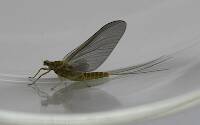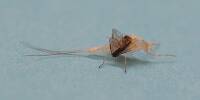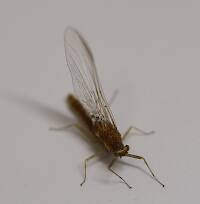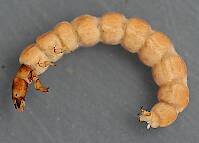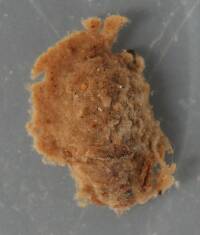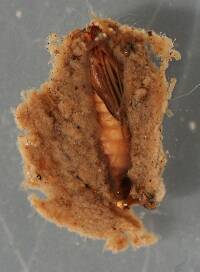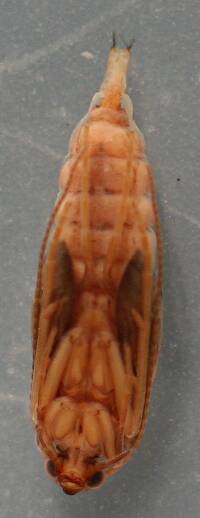
Blue-winged Olives
Baetis
Tiny Baetis mayflies are perhaps the most commonly encountered and imitated by anglers on all American trout streams due to their great abundance, widespread distribution, and trout-friendly emergence habits.
Featured on the forum

This specimen resembled several others of around the same size and perhaps the same species, which were pretty common in my February sample from the upper Yakima. Unfortunately, I misplaced the specimen before I could get it under a microscope for a definitive ID.

Troutnut is a project started in 2003 by salmonid ecologist Jason "Troutnut" Neuswanger to help anglers and
fly tyers unabashedly embrace the entomological side of the sport. Learn more about Troutnut or
support the project for an enhanced experience here.
This discussion is about the East Branch of the Delaware River.
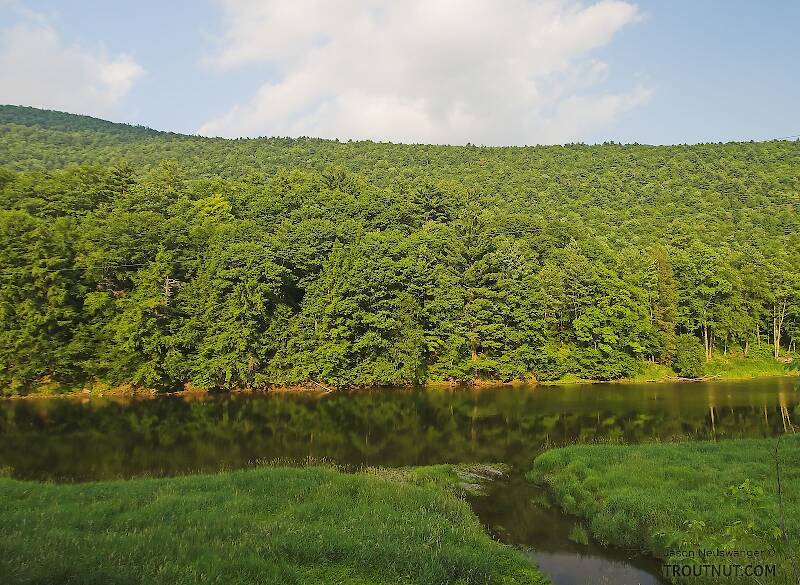
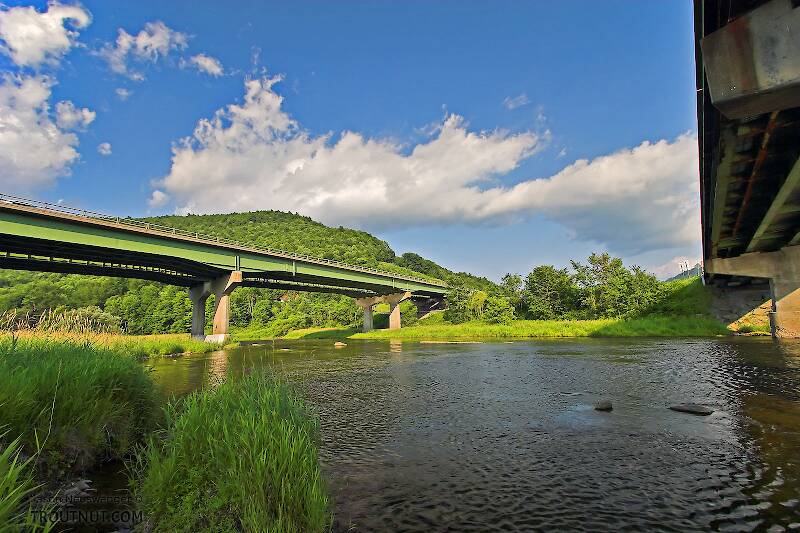
Softhackle on Sep 28, 2007September 28th, 2007, 12:47 pm EDT
I have seen some reports that the Didymo algae has been found, now, in the East Branch of the Delaware near East Branch, NY. The potential for spreading this "rock snot" as it is called is very high. The problem is it kills off insect populations because it smothers the stream and river beds. For more information regarding Didymo, look here:
Didymo
Mark
Didymo
Mark
"I have the highest respect for the skilled wet-fly fisherman, as he has mastered an art of very great difficulty." Edward R. Hewitt
Flymphs, Soft-hackles and Spiders: http://www.troutnut.com/libstudio/FS&S/index.html
Flymphs, Soft-hackles and Spiders: http://www.troutnut.com/libstudio/FS&S/index.html
Shawnny3 on Sep 28, 2007September 28th, 2007, 12:54 pm EDT
Thanks, Mark. Good to know.
-Shawn
-Shawn
Jewelry-Quality Artistic Salmon Flies, by Shawn Davis
www.davisflydesigns.com
www.davisflydesigns.com
Martinlf on Sep 28, 2007September 28th, 2007, 1:03 pm EDT
Oh no. I hope it doesn't spread, especially into the West Branch or Main Stem. Thanks for the alert.
"He spread them a yard and a half. 'And every one that got away is this big.'"
--Fred Chappell
--Fred Chappell
Softhackle on Sep 28, 2007September 28th, 2007, 3:08 pm EDT
Hi,
From the way I understand it they BELIEVE they have found this stuff in the East Branch. Tests are being done to confirm it, but from what I seen they are fairly sure it is there.
If I see any more information I'll let everyone know.
Mark
From the way I understand it they BELIEVE they have found this stuff in the East Branch. Tests are being done to confirm it, but from what I seen they are fairly sure it is there.
If I see any more information I'll let everyone know.
Mark
"I have the highest respect for the skilled wet-fly fisherman, as he has mastered an art of very great difficulty." Edward R. Hewitt
Flymphs, Soft-hackles and Spiders: http://www.troutnut.com/libstudio/FS&S/index.html
Flymphs, Soft-hackles and Spiders: http://www.troutnut.com/libstudio/FS&S/index.html
Konchu on Sep 29, 2007September 29th, 2007, 4:47 pm EDT
Most of NY's watersheds are linked by canals and channels now, are they not? This makes for a very scary situation.
Shawnny3 on Sep 30, 2007September 30th, 2007, 2:27 am EDT
I've been told that neoprene waders soak up microorganisms and carry them from one stream to another much more effectively than breathable waders do. It makes sense, but I don't know how true it is. Can someone more knowledgeable than I confirm this?
-Shawn
-Shawn
Jewelry-Quality Artistic Salmon Flies, by Shawn Davis
www.davisflydesigns.com
www.davisflydesigns.com
Lam on Sep 30, 2007September 30th, 2007, 2:29 am EDT
I've read that felt soles may transport the didymo more readily than rubber soles too.
Shawnny3 on Sep 30, 2007September 30th, 2007, 2:34 am EDT
That's interesting, because felt soles are probably much more likely to be used by serious, well-traveled fishermen than neoprene waders are (though I suppose most breathable waders still have neoprene feet).
Does anyone know a good way to decontaminate whirling or didymo organisms (or anything else) without damaging waders or boots? A mild bleaching, perhaps?
-Shawn
Does anyone know a good way to decontaminate whirling or didymo organisms (or anything else) without damaging waders or boots? A mild bleaching, perhaps?
-Shawn
Jewelry-Quality Artistic Salmon Flies, by Shawn Davis
www.davisflydesigns.com
www.davisflydesigns.com
Softhackle on Sep 30, 2007September 30th, 2007, 3:20 am EDT
more on Didymo
Take a look at this page for more info and cleaning solutions. We've really got to work together to prevent the spread of this stuff.
The news is not too good:
From the Post-Standard, Syracuse
Didymo found in East and West branches of Delaware River
Posted by David Figura September 28, 2007 4:45PM
The presence of didymo, an invasive plant species commonly called "rock snot" by anglers, has been confirmed this week by DEC officials on two, well-known trout streams in the Catskills.
Steve Lorence, fisheries manager of the Region 4 DEC office in Stamford in Delaware County, said sampling by DEC aquatic biologists has confirmed the presence of the slimy, brown-colored plant on at least five sections of the West Branch of the Delaware River, including the confluence with the Beaverrkill.
In addition, it's been found near the Route 191 bridge in Deposit on the West Branch of the Delaware River.
Unlike many other aquatic nuisance plants, didymo or Didymosphenia geminata, grows on the bottom of flowing and still waters. It can develop thick mats even in fast-flowing trout streams. In its presence, fishing becomes difficult, the abundance of bottom-dwelling organisms declines, and trout and other fish that feed on those organisms also decline. It resembles rotting cardboard when it dries and rots.
Its presence in the Catskill, often touted as one of the premier trout-fishing areas of the state, could mean trouble for an area where millions of dollars in tourism related to fishing is spent each year.
The microscopic algae cling unseen to waders, boots, boats, lures, hooks, sinkers, fishing line, and other fishing gear, and remain viable for several weeks under even slightly moist conditions, according to a DEC press release.
Absorbent items--for example, the felt-soled waders and wading boots commonly used by stream anglers-- can easily spread it. Canoeists and kayakers can also unknowingly contribute to its spread.
Mark
Take a look at this page for more info and cleaning solutions. We've really got to work together to prevent the spread of this stuff.
The news is not too good:
From the Post-Standard, Syracuse
Didymo found in East and West branches of Delaware River
Posted by David Figura September 28, 2007 4:45PM
The presence of didymo, an invasive plant species commonly called "rock snot" by anglers, has been confirmed this week by DEC officials on two, well-known trout streams in the Catskills.
Steve Lorence, fisheries manager of the Region 4 DEC office in Stamford in Delaware County, said sampling by DEC aquatic biologists has confirmed the presence of the slimy, brown-colored plant on at least five sections of the West Branch of the Delaware River, including the confluence with the Beaverrkill.
In addition, it's been found near the Route 191 bridge in Deposit on the West Branch of the Delaware River.
Unlike many other aquatic nuisance plants, didymo or Didymosphenia geminata, grows on the bottom of flowing and still waters. It can develop thick mats even in fast-flowing trout streams. In its presence, fishing becomes difficult, the abundance of bottom-dwelling organisms declines, and trout and other fish that feed on those organisms also decline. It resembles rotting cardboard when it dries and rots.
Its presence in the Catskill, often touted as one of the premier trout-fishing areas of the state, could mean trouble for an area where millions of dollars in tourism related to fishing is spent each year.
The microscopic algae cling unseen to waders, boots, boats, lures, hooks, sinkers, fishing line, and other fishing gear, and remain viable for several weeks under even slightly moist conditions, according to a DEC press release.
Absorbent items--for example, the felt-soled waders and wading boots commonly used by stream anglers-- can easily spread it. Canoeists and kayakers can also unknowingly contribute to its spread.
Mark
"I have the highest respect for the skilled wet-fly fisherman, as he has mastered an art of very great difficulty." Edward R. Hewitt
Flymphs, Soft-hackles and Spiders: http://www.troutnut.com/libstudio/FS&S/index.html
Flymphs, Soft-hackles and Spiders: http://www.troutnut.com/libstudio/FS&S/index.html
Lam on Sep 30, 2007September 30th, 2007, 8:17 am EDT
http://www.gmtrout.com/untitled89/index.html
the above web site, among others, offers tips on how to clean your gear to avoid transplanting didymo.
the above web site, among others, offers tips on how to clean your gear to avoid transplanting didymo.
Flybyknight on Oct 6, 2007October 6th, 2007, 12:25 am EDT
That is really grim news. I keep my camper at the Oxbow in Harvard and consider the East Branch to be my "home" waters.
New Zealand has a major scourge of didymo and they are addressing that plague with chemicals on at least one big river, and as I understand it, are having some as yet undetermined degree of success.
Dick
New Zealand has a major scourge of didymo and they are addressing that plague with chemicals on at least one big river, and as I understand it, are having some as yet undetermined degree of success.
Dick
Lightly on the dimpling eddy fling;
the hypocritic fly's unruffled wing.
Thomas Scott
the hypocritic fly's unruffled wing.
Thomas Scott
Martinlf on Oct 6, 2007October 6th, 2007, 7:30 am EDT
Let's hope they have success in New Zeland, that the chemicals aren't worse than the problem, and that someone takes initiative and nips this in the bud on the Delaware.
"He spread them a yard and a half. 'And every one that got away is this big.'"
--Fred Chappell
--Fred Chappell
AFISHN on Jul 15, 2015July 15th, 2015, 12:13 pm EDT
It is definitely in the West Branch
Tom
"..when i'm not AFISHN,I'm a huntin'... "
"..when i'm not AFISHN,I'm a huntin'... "
Quick Reply
Related Discussions
Topic
Replies
Last Reply
0
May 6, 2012
by Jesse
by Jesse
4
Apr 12, 2014
by Brookyman
by Brookyman
3
Dec 22, 2007
by Creno
by Creno





